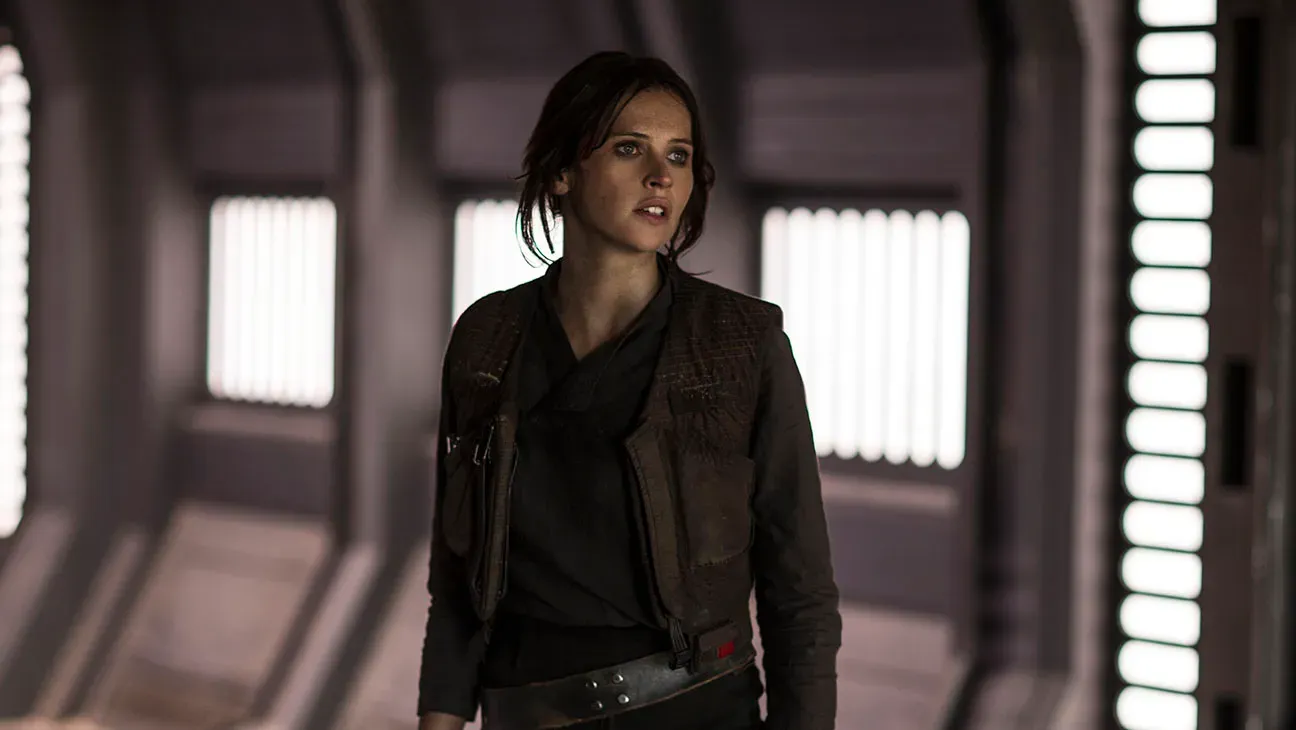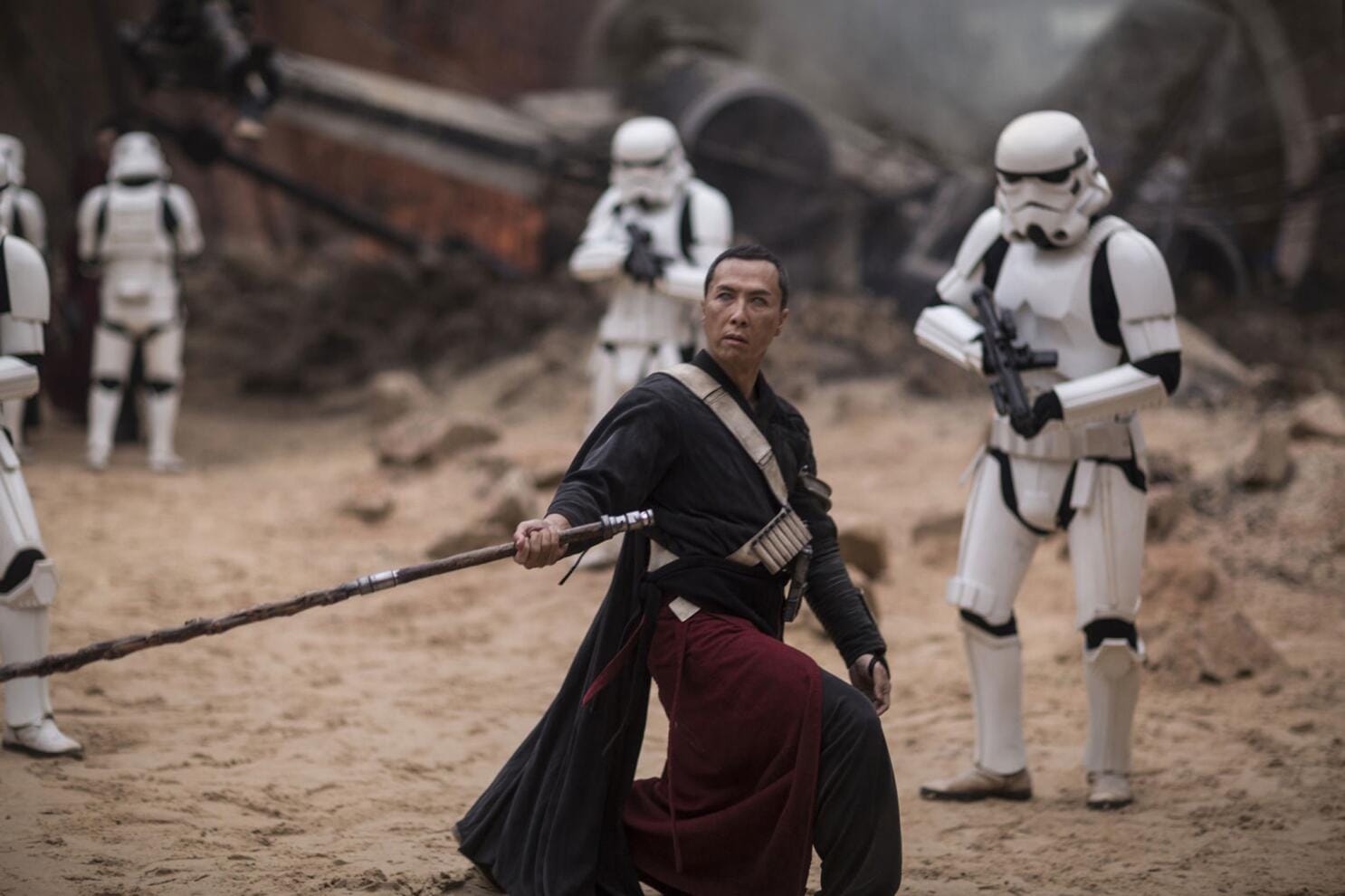10 Thoughts On ‘Rogue One: A Star Wars Story’
The 2016 film attempted to redefine what a ‘Star Wars’ movie could be and made the widely embraced spin-off ‘Andor’ possible. So why does it still feel like an outlier?

Today sees the premiere of the second, and final, season of Andor, a Tony Gilroy-created TV series set within the Star Wars universe. More specifically, it’s set in the gray areas not usually seen within other Star Wars projects, places where sacrifice and moral compromise are acknowledged elements of fighting for a cause, no matter how noble. Where George Lucas wrote the original Star Wars with Joseph Campbell’s The Hero With a Thousand Faces nearby, Gilroy seems to have had volumes of Graham Greene and John Le Carré on his desk.
A critical hit that’s picked up an impassioned fanbase, Andor is an offshoot of an offshoot. Released in December 2016, Rogue One: A Star Wars Story arrived just a year after Star Wars: Episode VII – The Force Awakens, the first Star Wars film released after Disney’s acquisition of Lucasfilm from George Lucas. As its full title suggests, The Force Awakens carried forward the storyline of the two previous trilogies. Rogue One did not. It was announced as part of a strategy that would allow Lucasfilm to alternate mainline installments with what the company dubbed “anthology” films. These would be standalone Star Wars movies that, while still recognizably of a piece with the rest of the series, could tell different sorts of stories in a variety of tones.
How did that work out? And how does it look nearly a decade on as Andor begins to bring the story it started full circle? I revisited the film for the first time since it played theaters and had some thoughts.

1. The digital recreation of Peter Cushing remains a ghoulish mistake.
I like Rogue One a lot so expect a lot of kind words below. But not yet. Then as now, the presence of a digital simulacrum of Peter Cushing remains jarring. Yes, it makes sense to include Cushing’s Star Wars character Grand Moff Tarkin in a story set immediately before the events of Star Wars. (A.k.a. Star Wars: Episode IV — A New Hope, but I grew up with it simply being Star Wars, so old habits die hard.) And, yes, Cushing’s pretty inimitable, so any actor assuming the role would not have an easy time of it. But the FX Cushing re-creation is at best a compromise born of the sense that nobody else could ever play the role (questionable) and at worst a tasteless stunt in pushing what effects could accomplish. Either way, it’s a huge distraction. Rogue One is filled with remarkable effects, but its attempts to have a faux Cushing that can’t quite climb out of the uncanny valley interact with flesh-and-blood human actors never work, giving the scenes an almost Who Framed Roger Rabbit-like quality. That’s just as true of the digital Carrie Fisher in the film’s final scene, but there’s less of an ethical ickiness to that moment since Fisher was still alive when the film was made and signed off on it. The distraction goes beyond 2016 special effects not quite being up to the task of resurrecting the dead. The “Ian Holm” of Alien Romulus is far more convincing, but no less horrifying.
2. Rogue One should be Exhibit A for anyone attempting to argue that extensive rewrites and reshoots can work
Rogue One began as an idea pitched by special effects whiz John Knoll as part of a never-to-be live-action Star Wars series developed by George Lucas prior to the Disney sale. The idea lived on into the Disney era with first Gary Whitta then Chris Weitz working on the screenplay. Knoll and Whitta retain story credit, with Weitz sharing screenplay credit with Tony Gilroy, who did extensive work on the film as writer and director after original director Gareth Edwards turned in his final cut of the film. (Per Weitz, Christopher McQuarrie, Scott Burns, and David Arndt also worked on the film, and the “thanks” section of the credits include nods to Christopher Miller, Phil Lord, Simon Kinberg, and others.)
To this day, it remains a fairly closely kept secret how Edwards’ original cut differs from the final version. Edwards has been diplomatic about the film, describing the process as a collaboration up to the end of the shoot in 2023. That Gilroy receives a script credit is a sign that his work was extensive. WGA rules favor the original writer and require later writers to have written at least 33% of the final script to receive credit. The degree of Gilroy’s contributions can at least partly be discerned by how much of the film feels of a piece with Gilroy’s work leading up to Rogue One, which includes the gritty Bourne movies, the morally complex Michael Clayton, the slept-on thriller Duplicity, and now, Andor. (Quite a bit, in other words.)
Occasional pacing issues and some underserved characters keep Rogue One from being seamless, but you otherwise have to look hard to see the stitches. (That the original trailer features dialogue and some obviously expensive images that didn’t make the final cut makes this all the more remarkable, especially considering how late in the process the changes must have been made.) My best guess is that Edwards, a strong visual stylist, created a solid foundation that Gilroy built upon. And what he built created a lot of opportunities for shade. (That metaphor might have gotten away from me, but you get the idea.) One way or another, it’s a visually stunning space adventure that looks at the Star Wars universe from a different angle and through a darker lens.

3. It makes sense that Cassian Andor would become the subject of a prequel series. Jyn Erso could easily have inspired one as well.
Taking a page from Kurosawa (not the first time a Star Wars film has done that, and Kurosawa drew inspiration from sources as ancient as Aeschylus’ Seven Against Thebes), Rogue One becomes the story of heroes from markedly different backgrounds who band together to fight an enemy despite overwhelming odds. A hardened agent of the Rebel Alliance, Cassian Andor (Diego Luna) is one of two central characters. As the film heads toward its final act, Cassian, speaking on behalf of a group of fellow Rebel veterans, says, “Some of us, most of us… we’ve all done terrible things on behalf of the Rebellion.” He could easily have added, “So many terrible things you’d need a two-season TV show to depict them all.”
Andor depicts Andor’s evolution from a reluctant Rebel to someone who’s built his life around the Rebellion. We learn much more about the early life of Rogue One’s other central character, Jyn Erso (Felicity Jones) but much less about the years between her childhood as the daughter of Galen Erso (Mads Mikkelsen) a scientist involuntarily building what will become the Death Star for the Empire and the moment she throws in with Cassian. Rogue One depicts her as having a difficult relationship with Saw Gerrera (Forest Whitaker), the leader of a band of Rebel terrorists who effectively raised Jyn after her mother’s death then abandoned her, he claims, in an attempt to protect her. Reduced to a few lines of dialogue. Jyn’s missing years are the film’s biggest blank spot and the clearest sign of late-stage tinkering. Jyn, and Jones’ performance, might be the biggest casualty of the reshoots and rewrites.
In an audio commentary recorded for IGN, Weitz refers to an earlier version in which Borr Gullet, who we see silently subjecting the Imperial pilot-turned-Rebel Bodhi Rhook (Riz Ahmed) to an invasive psychic probe, worked as a “memory trader.” “He lives on memories,” Weitz says, “and he especially delights on traumatic memories. They feed him. They’re more delicious to him. At one point, there was kind of a Space Hannibal Lecter scene where Borr Gullett made Jyn trade her traumatic childhood memories for information.” That sounds like the sort of intriguing material that could support a streaming series! (But it probably never will. Jones was most recently seen in The Brutalist and her filmography suggests that one dip into the world of big-budget franchise filmmaking, not counting a small dead-end part in The Amazing Spider-Man 2, might have been enough.)

4. Actually, just about any of the film’s major characters could have their backstories expanded.
This post is for paying members only
Sign up now to read the post and get access to the full library of posts for subscribers only.
✦ Sign up